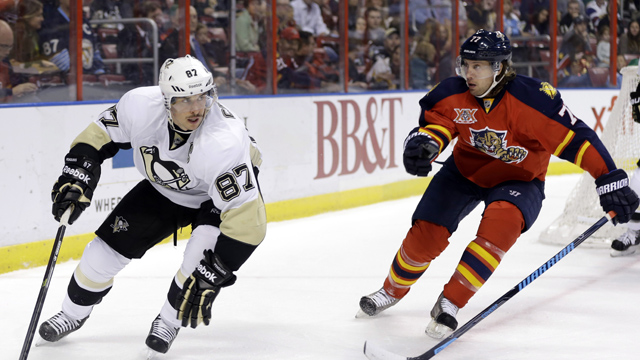As hockey analytics have developed, two points have emerged that should affect the evaluation of NHL defencemen. First, skaters do not appear to exercise any control over their team’s save percentage when they’re on the ice. Second, defencemen don’t have much control over their team’s shooting percentage when they’re on the ice.
Given this, the logical thing to do when assessing defencemen is to ask how they affect their team’s shots for/against when they’re on the ice. A tool to measure this is Corsi%. For the uninitiated, the formula is simple: Team Shot Attempts For (SAF)/(Team Shot Attempts For + Team Shot Attempts Against (SAA)).
The disadvantage of using Corsi% is that it isn’t an individual statistic. It’s not like on-base percentage, a number that you can look at quickly and understand whether or not a player is good at getting on base. You can, however, use the data to draw some inferences about the player and set some parameters for a discussion of what he is and what he might be in different circumstances.
Two seemingly identical signings made by the Florida Panthers days before the season illustrate this. On Sept. 28, the Panthers signed Tom Gilbert to a one-year deal worth $900,000. On Sept. 29, they signed Ryan Whitney to the same deal.
Whitney played six games for the Panthers, was waived through the league, and is currently playing for the AHL’s San Antonio Rampage. Gilbert has been paired with Brian Campbell and is playing 22:13 a night. The Campbell/Gilbert pairing has been one of the NHL’s very best, with the Panthers posting a Corsi% north of 55 percent when the two of them are on the ice.
A Corsi% of about 55 percent for a defensive pairing that’s playing top minutes is elite—only two teams in the NHL (L.A. and Chicago) are above that.. But when the Campbell/Gilbert pairing isn’t on the ice, the Panthers have been putting up a Corsi% of 49.2 percent, which is very run of the mill—the Flyers, 20th in the NHL in this metric, are currently running at a 49.2 percent. Without anyone noticing, Gilbert/Campbell has been one of the best 5v5 defence pairings in the league.
While nobody would have predicted that Gilbert would be part of one of the best pairs in the NHL, it’s not surprising that he turned out to be a useful contributor. It goes back to focusing on Corsi% as a measure of whether a defenceman is contributing to making a team better.
Let’s look at Gilbert with the Edmonton Oilers:
This is what’s known as WOWY analysis—With Or Without You. It’s a way of trying to tease out a player’s impact by comparing what happens when he’s on the ice with what happens when he’s not. In every season for which data is available, the Oilers were better with Gilbert on the ice than they were when he wasn’t.
Hockey being a team game, Gilbert is constrained by the players around him. We can slice the data another way and look at how Gilbert did with the forwards with whom he played at least 500 5v5 minutes between 2007–12:
A few things jump out. First, there are some odd gaps in this list. There’s a group of players bounded by Taylor Hall and Robert Nilsson who posted Corsi% of between 52.8 and 49.5 percent while playing with Gilbert. Unsurprisingly, all of those players save Nilsson (who may have been hard done by) are still playing in the NHL. Meanwhile, Andrew Cogliano, who has come into his own since leaving the Oilers, is the only player with a Corsi% between 44.9 and 49.5 percent.
There’s then a group of players, starting with Fernando Pisani, who posted sub-45 percent Corsi% with Gilbert on the ice. Three of those players have since departed the NHL. They were marginal NHLers at the time. Ryan Jones has bounced between OKC and Edmonton and has never really been a regular on a team that wasn’t bad. The only real NHLer in that group is Kyle Brodziak, whose numbers have improved in Minnesota, although they’re still poor.
A club looking at Gilbert’s time with the Oilers could quite reasonably conclude that, although the Oilers were bad, they were better when Gilbert was on the ice and that he spent a lot of time playing with guys who were technically NHLers, in the sense of being on an NHL team, but weren’t particularly good ones.
In Feb. 2012, Gilbert was traded to the Minnesota Wild. His numbers in Minnesota were as follows:
His 2011–12 was again a season in which he posted better numbers than the rest of his sub-par team. The next year saw him post his highest raw Corsi% number, but for the first time in his career his team did better when he wasn’t on the ice than when he was.
If you’re wondering why Gilbert got bought out, his on-ice save percentage in 2012–13 tells the story: It was a putrid .874. Through 2007–12, his on-ice save percentage was .911. If the save percentage behind a defenceman isn’t really connected to his work, it’s nothing to worry about, but it’s hard to get over a defenceman who’s on the ice for 12.6 goals per 100 shots when the league average is around eight per 100.
Despite this, when Gilbert became a free agent after being bought out by the Wild, he came with a pretty lengthy track record of outperforming his team’s Corsi% playing top four (and usually top two) minutes. For whatever reason, he couldn’t garner more than a training-camp invite despite the usual collection of defencemen who appear to be on fumes getting guaranteed NHL money earlier in the off-season.
Whitney was in the same position. Whitney’s a bit of an easier case. Let’s just do a straight comparison of Whitney with the various teams for which he has played since 2007–08.
If you looked at this data for Whitney, you would quickly conclude that he was horrible relative to his team in Pittsburgh. He matched Anaheim’s performance in a small sample in 2008–09 before suffering through a bad season relative to the Ducks the following year. He enjoyed a brief good spell relative to the Oilers following his trade to Edmonton in 2009–10 before entering what appears to be a terminal decline. His final two seasons in Edmonton, he was a full five percentage points worse than the team in Corsi% and frequently a healthy scratch.
In fairness to Whitney, he has suffered severe feet and ankle problems that don’t appear to have resolved well. That being said, his Corsi% data does not particularly resemble that of Gilbert.
If the Panthers went through a process like this and decided that Gilbert was worth a gamble, they deserve an enormous amount of credit. Gilbert’s almost certainly being carried by Campbell to a degree—Campbell has a fairly lengthy history as an elite defenceman—but any time you’re paying $900,000 for someone who makes up half of one of the best first pairings in the NHL, it’s an enormous win for your team. The Panthers aren’t a cap team and they need to find good cheap players in order to be competitive.
Of course, it’s a little difficult to conclude that the Panthers went through this sort of process when they signed Whitney the next day. If we’re drawing inferences about whether the Panthers are drawing inferences from Corsi% data, that’s a pretty compelling data point against such a conclusion.
Unlike in baseball, hockey data doesn’t provide a black or white record of a player’s value to his team. It does, however, provide an objective record of what actually happened with that player on the ice. A smart team will go through an exercise like this, possibly with better data, and try to isolate the players’ positive or negative impact. They can then contrast what the data is telling them with their subjective impressions and, where there’s conflict, attempt to figure out why. If it lets you find a guy who can be part of a good top pairing for $900,000 (or avoid giving a guy a $900,000 parting gift as he slides out of the league), it’s worth the effort.














